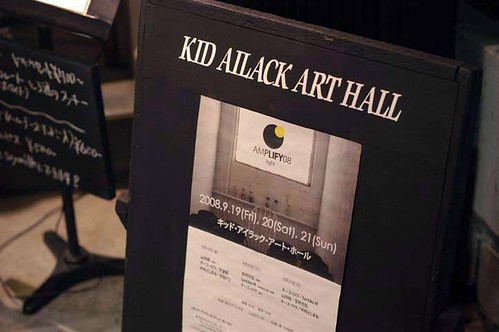
Over three days in which a typhoon struck Tokyo, the U.S. label Erstwhile which Jon Abbey runs with his wife Yuko Zama held a festival: AMPLIFY 2008: light, consisting of solo and duo performances of Japanese musicians and Keith Rowe. Rowe, known as a British avant-garde guitarist who invented a unique method of playing tabletop guitar and bowing guitar strings, was the main performer of the festival. The subtitle of the festival "light", which hints at a light seen in the future music, was Yuko Zama's idea, to dedicate the event to the late music critic and her mentor Toshihiko Shimizu who passed away in May 2007. This event can be noted as a unique experimental music festival, which reflected the label owner's personal vision directly into the selection of the performers, similarly to the recent IMJ's "ftarri" festival which Yoshiyuki Suzuki curated. I think that both of these events should be more appreciated by listeners, considering the fact that the label owners take a risk of bearing all of the expenses personally to realize the festivals.
There were several interesting aspects in the AMPLIFY 2008 festival: to be able to listen to Keith Rowe's 3-day live performance, who had come to Japan only three times previously, with AMM and other projects; as a pure practice of global interaction of improvisers that is meant to be always open beyond national boundaries; to witness what can be seen when the Japanese improv scene, which can be defined as "post-Off Site" movement after Onkyo in Japan, is set in a frame of experimental music from a different perspective. There was also an interesting aspect to interpret the label owner's vision as a criticism against the current improv scene through the festival.
Although Rowe played on all three nights, all of the possible combinations of musicians were not presented in the festival. Taku Unami, Sachiko M and Toshimaru Nakamura were the only musicians that played with Rowe, all in duos. Katsura Yamauchi played solo saxophone (the only traditional instrument seen in the festival) to open the festival, as well as a later duo with Mitsuhiro Yoshimura. The howling voice performer Ami Yoshida played only once, in a duo with Toshimaru Nakamura on the first night. Mitsuhiro Yoshimura, besides the aforementioned duo with his frequent recent collaborator Yamauchi, also did a solo performance, which for me evoked Sachiko M's early experimental sine wave work.
Since the program was formed only with solos and duos as mentioned above, the festival did not have so much possible variation that could be easily expected from this rather big event with 7 performers for 3 days. This simplicity must reflect the curator Jon Abbey's aesthetics. Except Keith Rowe and Toshimaru Nakamura who seemed to play the role of mediators of the whole festival, the other musicians tended to use minimal styles to segment one tone into details. This unique nature of AMPLIFY allowed an open space for the sounds to reach listeners' perception directly, Onkyo sounds dancing in our heads, without taking on a nature of festivity (of a village party, if I dare to say) which is common to most music festivals.
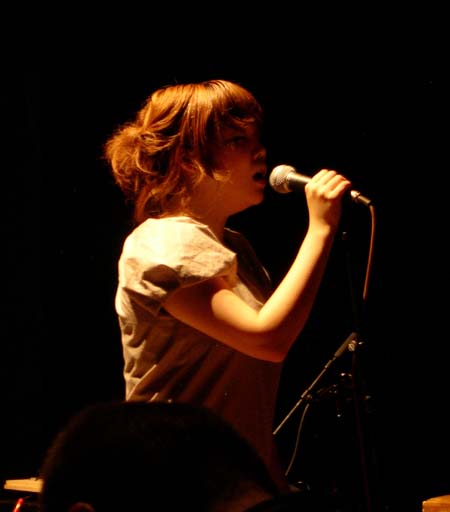
The "Onkyo sound" in this context can be likened to a tightrope act, walking on a wire in the air. A circus high tightrope walker forces the audience to fix their eyes on the single point on the wire where he is stepping, and the tension increasingly rises. In order to make the most of each moment, he dares to risk his life by choosing the uncomfortable, dangerous situation. If a tightrope walker falls off the wire, he cannot try it again. It is a one-shot deal, and the moment of bliss will never come back. Among the musicians who were "walking on a tightrope" of the festival, the most extreme example was perhaps Ami Yoshida's voice.
Howling voice requires difficult control to attain fragile tones from a vocal cord that is unstable itself, since vocal cords are affected by the performer's physical condition each day. It is almost beyond human control and perhaps even sometimes more difficult than what the performer themself might expect. Since Yoshida does not use any electronics devices to alter her howling voice, it is even harder to control. Also, listeners naturally tend to hear the howling voice as a human being's "voice" rather than "acoustic sounds", even though the performer insists that they are simply considered to be acoustic sounds. This is perhaps because our brain’s networks are not formed to listen to human voices in that way. In fact, our ears cannot listen to a voice as simple acoustic sounds separate from the person whose voice it is. A voice performer cannot play her voice just like playing an instrument, since the voice more directly represents the performer – in this case Ami Yoshida herself.
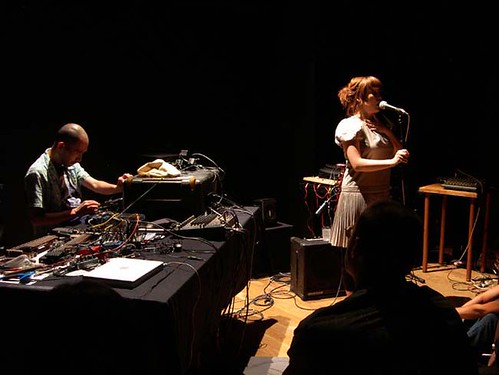
The vibration of Ami Yoshida's vocal cords that stems from the deep place where her body and mind connect can also be described as peering into the darkness at the edge of her spiritual cliff. Toshimaru Nakamura's performance wrapped around her performance with a structure of figure and ground appropriately. For Ami Yoshida's voice that has no landing site without any supporting context, Nakamura offered a stable chair on which Yoshida could stay in the air safely. If we use another metaphor from the circus, Nakamura put up safety nets like a spider's nest in the air. Nakamura chose his sounds to let Yoshida’s performance have all the space she needed without disturbing her voice at all. Compared with Ami Yoshida and Gozo Yoshimasu's first duo performance that I saw several months ago, which assumed a crisis-like character, I could see that Yoshida and Nakamura had already established their own methodology despite this being their first duo set ever. Nakamura's skill as a mediator should be more highly regarded.
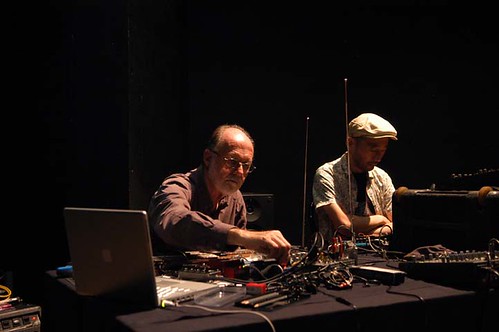
In a way, the 6th AMPLIFY festival which was held in Tokyo was already structured in advance by the qualities of the seven musicians performing. In general, musicians who played with the limited/alternative method sometimes referred to as ‘reductionism’ were Katsura Yamauchi, Taku Unami, Mitsuhiro Yoshimura and Sachiko M. Keith Rowe and Toshimaru Nakamura also played their instruments to make sounds within this reductionist aesthetic, but that does not mean that they used the same sounds in every set. They changed their sounds in each set to deal with the different environments, which means that they did not restrain their performances to one limited style of improvisation. Rowe and Nakamura did not play like tightrope walkers who walk on a wire. They appeared as performers who conveyed various layers of music behind each separate performance. They had always prepared several ideas for which direction to go or what to choose. This quality of these two musicians must have led them to be mediators of the festival. I understand why the festival was concluded with their duo set.
Perhaps we can draw a borderline here. Some people may criticize some of the paths that Rowe and Nakamura chose as a retreat to the old-style improvisation, which might also mean a defeat of the Onkyo movement against the established nature of free improvisation. However, I do not think that it is creative to be reductionist simply for the sake of reductionism, and ignoring the various circumstances of each occasion. That would be just dogmatism. In the end, the only thing a musician can do is to be true to their own quality that they are destined to deal with for their entire life.
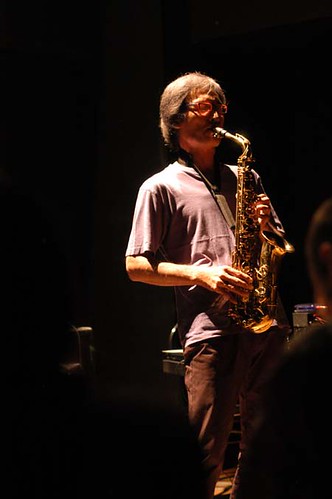
Among the musicians who worked in the reductionist style at AMPLIFY, the ones whose sounds stemmed from their own flesh and blood with no electronics use were Katsura Yamauchi and Ami Yoshida. Apart from the content (see footnote #1 for explanation of this term) of the music, they seemed to try to reach somewhere beyond the modernism of improvisation, and yet this also resulted in appealing to the layers of history of human memories. This happened because they presented voice and instrument on stage in a traditional way.
While there are sounds that are generated from electronics devices with no direct connection to human memories, there are other sounds which dig into the core of the human body and reach the depths of history just like finding a new layer of ore. In the junction of the tabula rasa state of neo-futuristic electronics music and the ancient memories of human beings, we experience a confused sense of time when we hear the sounds. Possibly our modernist method of dealing with time collapses when forced to deal with this kind of approach. In any case, whether the performer's body is actively involved with the performance or not (the fact that it is related to the oral airway like vocal cords or breathing is very important here) is a point, and we can draw another borderline here.
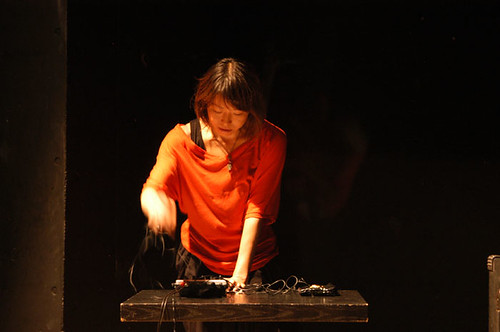
Here, Sachiko M showed up to destabilize the borderline. We may call the performances of Keith Rowe, Taku Unami, Toshimaru Nakamura and Mitsuhiro Yoshimura with an old term live electronics. But Sachiko M's contact mike performance, in which she seemed to play closely with her sense of touch and not just actively involving her fingers with the performance, was different. Just like she picked up sine wave from a sampler, her contact mike performance is based on her intentional misuse of dealing with it like a scrap, not using it as acoustic equipment. She played this recording device, which is supposed to keep silent for the sounds to be recorded, like an amplification device. The contact mike is played to make sounds based on reality, totally free from any memory, while being closely related to her physical being - especially to her sense of touch that can be called cognition of fingers.
Our sense of touch is closely related to our own memories. But it has nothing to do with music in general and is related to different sensations from sounds, such as a pleasurable feeling to touch a lover's skin or a finger to touch a fruit in the kitchen to check how ripe it is. Using contact mikes, Sachiko M established her performance to interact with listeners through a coupling of sense of touch and memories, not by means of a coupling of acoustic sense and memories. She focused the spotlight on the entanglement of subject and object that arises at the birth of sounds, by entwining her fingers on and off the contact mikes, not only with focusing the texture of objective sounds, but also with the cognition of fingers.
On the other hand, the physical senses that sustained Katsura Yamauchi and Ami Yoshida's performances involved the layers of history of human memories, which could sound romantic to some listeners. But the physical sense of Sachiko M is always sliding within a highly aware realm, sticking to complete realism. Her self-definition of "I am not a musician" should be regarded as a key phrase in this context, deeply related to this specific performance.
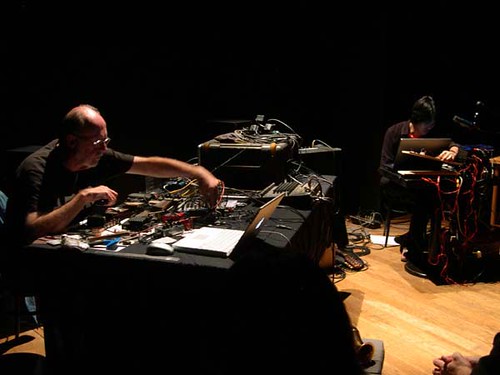
Just like Derek Bailey used to do, the festival's key musician Keith Rowe seems to fold the layers of several generations of improvised music history into his performances with his background as a long-term musician. He may appear to be a tightrope walker on the surface, but what he played was a live electronics improvisation that could be regarded as a translation act of putting his memories into electronics sounds. It was impressive that he was willing to move towards his co-performers such as Taku Unami, Sachiko M and Toshimaru Nakamura to open a space for dialogues, setting aside his own firm aesthetics that he has built with AMM over many years. It was not like he was donating his time and energy for co-performers from younger generations as a master of free improvisation, but instead, he was genuinely trying to communicate with them with an open mind by paying careful attentions to the environments, always starting fresh with a clean slate in each set. I can tell that this open heart of welcome style of approach made it possible to organize radical improvisation orchestras like MIMEO.
In his solo set, Rowe added some samples of old classical music to realistic electronic sounds that were close to the original style of noise music, occasionally using a portable fan which evoked a propeller noise. The old-world feeling of the sampling and noises that Rowe brought in the performance seemed to be overlapped with his own old memories. In fact, he mentioned that a propeller noise evokes the noise of air raids to him, as he spent his childhood in the midst of wartime. As seen in this fact, Rowe's improvisation is defined with his multilayered experiences and consciousness beyond simply the typical boundaries of 20th century experimental music. This is why his music is performed with infinite disparity every time he plays, even without co-performers and even in this time of the “avant-garde” concept losing its value.
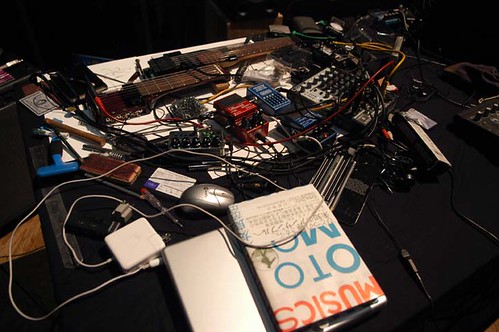
If Ami Yoshida and Katsura Yamauchi are trying to pull something from the old layers of history of human memories that are beyond their own individual consciousness by lowering down their resonant sonde deep into the core of the body - or the central information center of the body. (Of course, it does not mean that they can always reach the old layers of history by exploring their subconscious area every time they play.) On the other hand, Rowe's way of presenting the memories is quite bibliographical. Here is another explanation: Rowe's work table where his guitar rests is just like his study room where his books for reference are piled up high, and his improvisation is performed just like writing a text on brand new paper. However, his performance is not directly descriptive, like expressing his wartime experience with actual sounds of strafing. Instead, he uses indirect sounds such as a propeller noise as an implication, like writing a poem. Perhaps Rowe began the process of performing music on his worktable during the time of AMM. If so, perhaps Rowe is putting elements of his performance on his table one by one, whatever it is Onkyo or reductionism, just like reading a new book. He may not understand some parts instantly, but after reading it repeatedly, he may get it just like filling additional writings between lines.

Needless to say, none of his co-performers, who were walking in a straight, focused line using reductionism-style improvisation, spent their time cultivating their own workspace to collect miscellaneous elements during their sets. Compared with Rowe who was playing like a writer, every co-performer seemed to play much more simply without walking too far from themselves in a text-independent environment. Of course, this was why listeners were able to concentrate on their sounds and be free from the excessive information overflowing in this post-modern time, and could experience the total picture of being, via this self-limited improvisation performance style.
Accordingly, the limited/alternative style of improvisation represented by reductionism seems to be the approach that remains most in actual practice, in spite of various recent attempts to deconstruct the established conventional improvisation performances. For those simple styles of performances, it does not matter if the music is considered a paradigm shift in the history of improvised music or not from a macro viewpoint. Improvisers from the older generations have built their own specific identities by polishing their skills playing free music, to eventually stand on stage as experts of instrumental performance. However, to reach the state of reductionism, they have to abandon their established identities. There were musicians like Derek Bailey who had tried to expose the origin of performance by returning to simple styles of music without abandoning their own expertise.
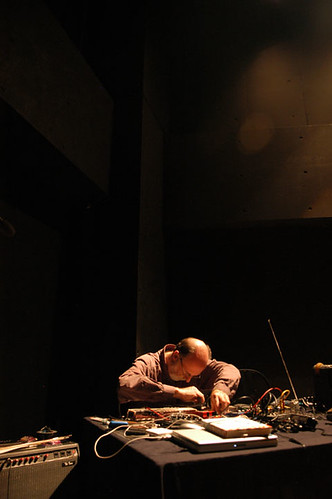
A reductionism musician tries to make the audience observe the moment when his new identity is constructed each time, instead of reconstructing his identity that was already established at some point in the past. It should remind the audience of the pure methodology of improvisation with which the musician convinces the listeners that the performance is born in this moment, without originating in the past. Perhaps only someone like Keith Rowe – who not only has an open mind of hospitality, but also who can reset himself every time he plays while having a history of being a constructive improviser - is able to show empathy for this new style of Onkyo reductionists. In Rowe's flexible behavior during AMPLIFY 2008, I saw a rare nature that is difficult to find in the U.S. and European improvisation scenes where pushing one’s own identity to the forefront is usually believed to be a virtue. Perhaps Rowe is trying to practice nomadism in the free improv scene, which the late German musician Peter Kowald had been pursuing, too. I understand well why Jon Abbey of Erstwhile values Rowe highly.
Like John Zorn did in the past, Jon Abbey considers the Japanese improv scene to be crucial, and held his label festival in Tokyo for the second time. He considered Keith Rowe as the main performer, included the remarkable mediator Toshimaru Nakamura as an advisor, included avant-garde idols Sachiko M and Ami Yoshida (not every listener may be able to enjoy their performances, but their presence is important to remind of the fact that experimental/improvised music does not belong to only men) to document their current activities, and included Taku Unami, Katsura Yamauchi and Mitsuhiro Yoshimura as new voices in the scene.
The festival covered a broad range of performances. Katsura Yamauchi presented his European approach using limited/alternative improvisation style by using breathy tones often. Mitsuhiro Yoshimura kept letting out continuous sound like sine wave on and on by using feedback noise of headphone/microphone in a darkened room - it was impossible for the audience to see how he played. Keith Rowe and Taku Unami's duo presented unique installation-style electronics music using a contrast of the speakers' location, with an indistinct combination of their sounds making it hard to distinguish who played which. Ami Yoshida inclined the audience's mind to her howling voice, which created a charged atmosphere in every moment. Sachiko M adhered to her own acoustic realism with an unparalleled contact mike solo performance. Keith Rowe and Sachiko M's duo sounded like solo plus solo rather than a duo performance. There was a duo of Yamauchi and Yoshimura. Then at the end, Rowe and Nakamura presented aggressive duo music like a rock in which Rowe returned to his drone performance.

The curators said that one of the most important purposes of having this festival in Tokyo was to realize the duo of Keith Rowe and Sachiko M. Rowe admires Sachiko M's performance, in which she looks into her self and simply digs deep into the core of her being, as one of the most influential musicians for him. It sounds like the most accurate understanding of Sachiko M's music. In the field of the Onkyo music or limited/alternative improvisation, it seemed that only general theories dominated without considering discrete theories enough for each case so far. That was why Sachiko M and Toshimaru Nakamura have often been mentioned synonymously with Onkyo music. What we need to try is to reconstruct the diversity of music with a fresh approach each time by setting the origin of sound in the 'here and now’ (especially for improvised music) in the field of music criticism, too.
*1: I call it "content" here for convenience, but it might be almost impossible to interpret Ami Yoshida's voice which sounds like a murmur of an unborn baby who is about to become a human being, or Katsura Yamauchi's breath which changes a horn into somewhere like a cave exposed to the wind. These sounds can barely be explained by anomalies of conventional saxophone or voice performances. These sounds seemed to be born without being related to any conventional way. How to describe these sounds is a big issue for us.
(translation by Yuko Zama)
2 comments:
this is great. i have read a couple of the other reviews posted on IHM, and this one is a welcome contrast in perspective. thanks, and please keep it coming!
Finally got around to reading this. There are some nice perceptive thoughts in the review.
I'm thinking of the idea that what Toshimaru Nakamura does is provide a "ground" in the sense of 2d art, for other musicians to add figures on top. That's not a new idea but connecting it with "Side Guitar" and how he mentions having always wanted to be a rhythm (side) guitarist.. it is as if that is indeed what he does in improv settings - stasis and longer durations between changes functioning like a rhythm accompaniment. This is why what he does makes him a consistently capable collaborator.
As in most musics, it seems that more people want to be soloists and not enough musicians want to accompany (ever tried to find a decent drummer?).
Post a Comment